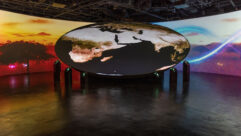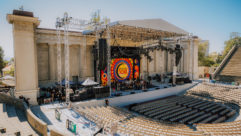
Beyond Books
May 13, 2013 1:17 PM,
By Tim Kridel
Building the multimedia library of the future

What is a library supposed to be these days? That fundamental question created a host of AV challenges and opportunities at North Carolina State University’s James B. Hunt, Jr. Library, which opened earlier this year to accolades, including the distinction as one of the world’s “25 coolest college libraries.”
Much of that cool factor comes from the generous amount of AV, which both reflects and enhances NCSU’s reputation as one of the world’s top schools for engineering and technology. For example, NCSU’s degrees include a minor in game development, so the Hunt Library includes a lab with features such as gesture-enabled interactivity and “stealth glass” that turns opaque with the flip of a switch to hide games in development.
Another example is the visualization lab, which features 32 ceiling speakers, a surround-sound system, 10 projectors, and 280 degrees of immersive video. It’s used for applications such as viewing 3D renderings of buildings or cells. Once a month, the U.S. Navy uses the room to train ROTC sailors.

“The front wall is displayed as if you’re looking out the bridge of a ship, and the sides are flatpanel displays that emulate portholes,” says Mark Valenti, president and CEO of The Sextant Group, which was the library’s technology consultant.
Longer and wider than a football field, Hunt Library still has books, but two million of them are compacted into one-ninth the space that a traditional library requires. That efficiency comes from bookBot, an automated system that retrieves books within minutes of a request. In the process, bookBot frees up space for more AV and IT systems to achieve NCSU’s vision of how libraries are evolving.
“The vision of the library is not as a warehouse for books but as a portal for access to digital information of all kinds,” Valenti says. “In our minds at the Sextant Group, the library of the future is one of visualization, multimedia access and collaboration. This building is chock full of those spaces and technologies.”
The upshot essentially was a blank slate for Sextant, AVI-SPL, Biamp Systems, and the other companies involved with the project.
“A library is a different thing now,” says Julian Treasure, The Sound Agency chairman and one of the presenters at the library’s April 17 dedication. “It’s not like the old days, when it was ‘Shhh!’ and all you heard was the rustling of pages.
“Now a library is a place where you can do collaborative work, experience multimedia, listen to audio, see a movie. So the function of the space is different than what it used to be.”
1
Beyond Books
May 13, 2013 1:17 PM,
By Tim Kridel
Building the multimedia library of the future

The Right Amount of Noise
For all its emphasis on multimedia, the Hunt Library still is a place where a lot of students and faculty come to read and study. To provide peace and quiet, copiers and vending machines are tucked in rooms with doors. The main reading room features wooden sound diffusers that look more like architectural features. “They look gorgeous,” Treasure says. “They do a fabulous job of breaking up the sound waves and creating a space that’s lovely to be in.”
The library also uses networked audio in rooms such as the visualization and gaming labs.
“Because of that, we’re able to very exactly zone the sound,” says Graeme Harrison, Biamp Systems executive vice president of marketing. “All of the multimedia is pretty much contained within specific rooms. The overall effect is that it’s a very quiet space.”
Even so, the reading room and other traditional spaces aren’t 100-percent silent by design.
“You need a little bit of HVAC and a little bit of human activity, just enough to mask a conversation so you don’t hear people 50ft. away but not too much that it doesn’t disturb you from working,” Treasure says. “Nobody wants to listen to pink or white noise. When you put noise on top of other noise to mask it, it’s like putting perfume on a stink. You’re better off removing the stink in the first place.”

Simplicity Amid Complexity
Some of the rooms at Hunt Library are configurable, which created challenges at the time of installation. One example is the creativity lab, whose features include shared videoconferencing codecs that can be assigned to different zones on the fly.
“The walls are on ceiling tracks and can divide the space into many small spaces,” says Mike Cenzer, AVI-SPL project manager. “The projectors can be moved to display on any of these movable walls. It took a lot of brainstorming and late nights to look at all of the potential combinations and how they would be accomplished in the room and on the touchpanel control.”
Another example from the creativity lab is configuring the 32 audio zones, such as to create an immersive experience.
“They wanted to be able to set up different sound fields where they can route audio from any source to any location [for] simulations,” says Holt Stevens, the AVI-SPL senior design engineer who coordinated the installation team.
These kinds of variables added to the basic challenge of making the control system intuitive enough that faculty and students wouldn’t need a lot of handholding by library staff.
“On the programming end, due to the complexity of some of the larger systems, NCSU was looking for as much flexibility, combined with simplicity, and innovative controls not typically seen in most AV control system touch panels,” Cenzer says. “This meant we needed to incorporate 3D models into touchpanel designs, implement drag-and-drop features, video preview with thumbnail snapshots of sources and VNC controls, all which are features of AMX’s MXT newer line of touchpanels.”
Cenzer and AVI-SPL’s interaction designer worked with NCSU’s team, which included a graphic designer and interface designer to meet the client’s needs. “We held many programming design meetings with the client over WebEx, over the phone, and in person to flesh out the desired details,” Cenzer says. “Since AV programming generally relies on test-driven development, interacting with some of the new hardware and complex systems while programming was required, increasing development time but providing the results the customer needed.”
One place where Hunt Library looked to the past is Biamp’s Audia platform, which is an 11-year-old product. Sextant chose Audia partly because it was a proven product at the time that the project’s design was finalized.
“We know that it’s rock solid and reliable,” Valenti says.
Audia also didn’t mean trade-offs.
“They have a solution that does everything they want and more and is capable of growing with them,” Harrison says.
2
Beyond Books
May 13, 2013 1:17 PM,
By Tim Kridel
Building the multimedia library of the future

AV Meets IT
Hunt Library’s multimedia features meant that AV and IT systems would have to work together seamlessly. For example, the IT work room has an adjacent server room with 16 water-cooled racks, half of which are dedicated to AV. That’s key because the IT work room hosts media and routes it to different rooms over a 10Gb fiber backbone, with 48 strands to each room. The infrastructure also is in place so that in the future, the IT work room can remotely control AV assets, such as turning projectors on and off throughout the facility.
“They can monitor everything from the control room in the IT work room,” Stevens says. “They [also] can send media and manage it from the work room. It’s a really nice feature for the university to be able to do that.”
In other projects, AV access to IT infrastructure often is hard to get for reasons such as the IT staff’s concerns about security and bandwidth. At Hunt Library, one person almost singlehandedly changed all that, according those who worked with him: Maurice York, NCSU Libraries head of IT.
“Maurice was better than awesome,” Stevens says. “He almost seems like more of an AV IT guy than an IT AV guy. He understands it better than any IT guy I’ve met. I wish we had that every time we went on somebody’s network.”
For example, York provided tips for configuring switches and other network elements that handle AV and IT so the two traffic types aren’t stepping on each other. That assistance was particularly helpful for the control system, which uses Extron XTP for transport.
“The control on this job was almost exclusively IP,” Cenzer says. “We worked with the IT department to make sure we had the resources needed: VLANs, IP addresses, and VoIP setup.”
York also was instrumental in finding the budget to enable the AV designs to push the envelope and redefine “library.”
“The initial budget for the AV system was about one-sixth of what they ended up spending,” Harrison says. “They said, ‘This is how much we have to spend,’ and Sextant Group said, ‘Okay, this is what we can do with that, but this is what you really should have.’ Then Maurice came back and said: ‘I want to go for that. I’m going to raise the money to do it.’”
3










